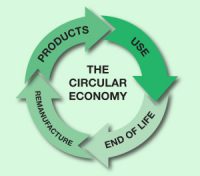A report analysed circular economy business practices and “suggests regulatory actions to unlock full growth potential”.
A report prepared for the EU Commission (EC) has acknowledged regulatory obstacles and loopholes in the law that are obstructing Europe’s circular economy, reported CIWM Journal. The obstacles were identified as blocking remaining opportunities, and are in “sectors, subsectors, economic activities and value chains”, and the report offers “possible solutions”.
Analysts looked at the life cycle of products and the boundaries between the steps of: extraction; production; production internal loops; production use; collection; waste-management; and recycling, and found that these barriers are concentrated within three themes. The report noted that there were regulatory barriers relating to the collection of waste streams, and that this was due to “lacking legislation that would allow the collection and pre-treatment of homogenous waste streams”.
Without this legislation “many waste streams end up as mixed waste”, and that this was where “higher quality recycling costs were higher than the income from its recycled materials” – an example was that of plastic packaging. Secondly, the report referred to a barrier that has laws that “hinders the use of recycled materials in production processes”, motivated by “health and consumer protection”, undermining benefits and chances of “circular approaches”.
It added that there was “a lack of harmonised EU legislation mandating specific quality requirements” which impedes high quality recycling. Lastly, it was noted that there was a “lack of concrete and enforceable product requirements” related to the problems enforcing “the requirements of the WEEE Directive for the recyclability of electronic products” and especially the “disassembly of batteries”.
General types of barriers were also identified, and it said that “in many cases waste legislation focuses on quantities (weight based collection or recycling targets) and not so much on the qualities of recycled materials” and that there were “inconsistencies between existing regulations”, like those related to “REACH or End-of-Waste criteria” for example.
The report concluded that generally “high-quality recycling is definitely not prevented by regulatory obstacles” but more by a lack of or unclear legislation, and that major examples were that of “End-of-Waste criteria or quality standards for secondary raw materials”, which “create legal uncertainties for the industry that make it rational to continue to focus on primary raw material input”.
A lot of the concerns identified are already being given attention and are “being addressed through the circular economy action plan”, according to the EC, and that there was ongoing analysis of “the interface between waste and chemicals legislation [and] the development of plastics strategy”, while “ongoing and scheduled REFIT exercises will also be informed about the results of the study”.
The results of the study do not mean that “all barriers can be removed”, such as those that stem from “different, possibly conflicting regulatory objectives like public or animal health [or] environmental protection”, and any of these are can be looked upon as more important than the circular economy. There is also the fact that “regulatory arrangements can be part of a very complex system that may be difficult or expensive to change”.
